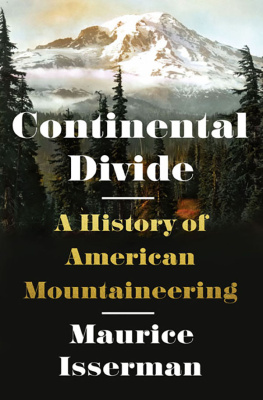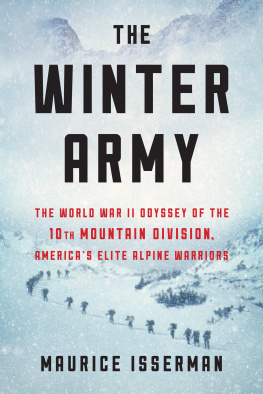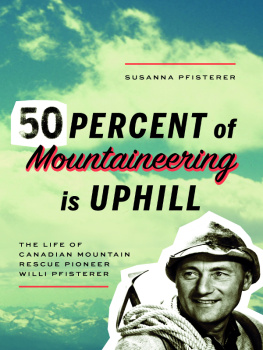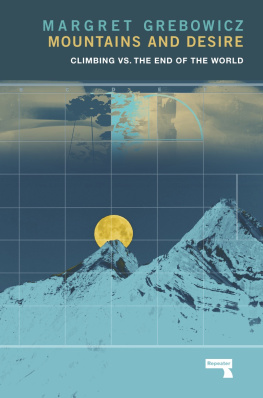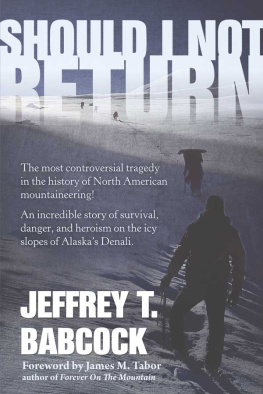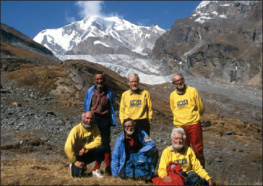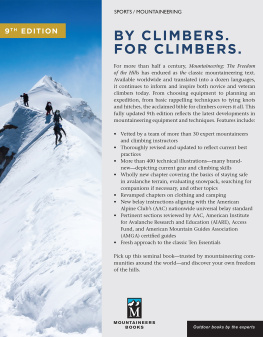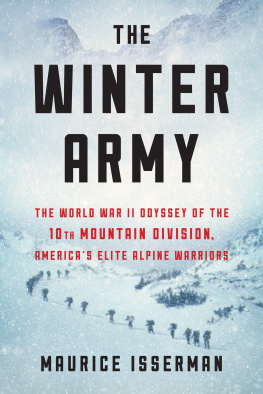
Continental Divide is dedicated to those Oregon friends
in whose company, in younger days, I first encountered mountains.
I keep a mountain anchored off eastward a little way, which I ascend in my dreams both awake and asleep.
HENRY DAVID THOREAU,
NOVEMBER 16, 1857
What we call a mountain is... in fact a collaboration of the physical forms of the world with the imagination of humansa mountain of the mind.... Mountainslike deserts, polar tundra, deep oceans, jungles and all the other wild landscapes that we have romanticized into beingare simply there, and there they remain, their physical structures rearranged gradually over time by the forces of geology and weather, but continuing to exist over and beyond human perceptions of them. But they are also the products of human perception; they have been imagined into existence down the centuries.
ROBERT MCFARLANE,
MOUNTAINS OF THE MIND, 2003
CONTENTS

CONTINENTAL DIVIDE

T his is a
And yet, if Americans remain ambivalent about mountaineers, mountains themselves are regarded as sacred places in the American landscape, second only to battlefields, part of the mystic chords of memory that Abraham Lincoln referred to in his first inaugural address, and that bind together the nation. The experience of touring a Gettysburg battlefield is expected to leave the visitor improved and even exalted. A visit to a mountain summit is supposed to offer a similar (if less sanguinary) sense of uplift, even if accomplished by mechanical transport (Americans may be the only people on earth who brag about driving to a mountaintop, as the ubiquitous This Car Climbed Mount Washington bumper stickers in the Northeast attest). The present American veneration of mountains did not always exist, and this book is an attempt to account for how it came to be.
This is my second book devoted to the history of mountaineering. The first, coauthored with fellow historian and occasional climbing partner Stewart Weaver, was Fallen Giants: A History of Himalayan Mountaineering from the Age of Empire to the Age of Extremes, published in 2008. That book began with a disclaimer that I feel honor-bound to repeat here: I am not (alas) a climber of the caliber of those whose exploits I will be chronicling in this book. Many of the climbs I describe in these pages have been recounted before by the actual participants, and some of those (among them Henry David Thoreau, John Muir, Charlie Houston, Bob Bates, Bradford Washburn, and Tom Hornbein) were writers who brought grace and insight to the task.
What I bring to this project is a historians perspective. Which is to say that I start from the assumption that American climbers, from 1642 to the present, were and are the products of their own eras, and the reasons why they climb, as well as the ways that they climb, can help map a larger cultural, political, and social terrain. Continental Divide is thus a book about American history, as seen through the prism of mountaineering.
Although I have tried to provide as comprehensive an account as possible, I have not attempted to write the Encyclopedia of American Mountaineering. Inevitably, in weighing the contractual limits of the space available to me, the likely limits of readers patience, and the brevity of our allotted time on earth, I had some difficult choices to make about which climbs and climbers to include oralas, all too oftento omit. I also felt that with the establishment of mountaineering as a mass participation sport in the United States in the mid-1960s, I had reached the logical outcome of the story I was attempting to tell. I thus offer only the briefest glance at the half century that followed, a time of first-rate mountaineering achievements including, as I was putting the finishing touches on this book, Tommy Caldwell and Kevin Jorgesons first free ascent of the Dawn Wall of Yosemites El Capitan in January 2015.
In the seven years that I have been at work on this book, I have accumulated a small mountain of debt to those who have assisted along the way. Two institutions, one in the East and one in the West, were critical to my research: the Appalachian Mountain Club Library and Archives in Boston, Massachusetts; and the Henry S. Hall Jr. Library of the American Alpine Club in Golden, Colorado. I spent many hours of research in their pleasant reading rooms, and bombarded their patient and ever-helpful staff members with literally hundreds of follow-up e-mails requesting additional information. In particular, I am indebted to Becky Fullerton, director of the AMC library, as well as Dana Gerschel, director, and Katie Sauter, manager, of the AAC library, and their assistants, Allison Bailey and Dan Cohen. Reid S. Larson, reference librarian at Hamilton College, was also invaluable, as were Rare Book Room director Christian Goodwillie and photographer Marianita Peaslee. So, too, have been librarians at the Bancroft Library of UC Berkeley, the Department of Special Collections at Stanford University, and the Howard Gotlieb Archival Research Center at Boston University.
I am also grateful to the following individuals (climbers, climbing historians, climber friends, and relations) for their assistance: Kathy Bedayn, Walter R. Borneman, Nick Clinch, Gretchen Daiber, Greg Glade, Sallie Greenwood, Tom Hornbein, Katie Ives, Steve Jervis, Bruce Johnson, Russell Lawson, David Mazel, Jim McCarthy, Bernadette McDonald, John Middendorf, Pat Morrow, Phil Powers, Bill Putnam, Todd Rayne, Zac Robinson, Steve Roper, Martha A. Sandweiss, Jay Taylor, and Stewart Weaver. Doubtless there are others Im forgetting, for which I apologize. Any errors that have crept into the pages that follow are, of course, solely my own responsibility.

Well could I curse away a winters night,
Though standing naked on a mountain top,
Where biting cold would never let grass grow,
And think it but a minute spent in sport.
WILLIAM SHAKESPEARE,
HENRY VI, ACT 3, SCENE 2
And it shall come to pass in the last days, that the mountain of the LORDs house shall be established in the top of the mountains, and shall be exalted above the hills; and all nations shall flow unto it.
ISAIAH 2:2, AUTHORIZED
(KING JAMES) VERSION
I n the spring of 1642, in what was then the Upper Plantation of Massachusetts Bay Colonylater the colony, and still later the state, of New HampshireDarby Field, a thirty-two-year-old Englishman of Irish descent, was doing something unprecedented in Englands newly established North American colonies: climbing a mountain.
Field, a resident of the community of Pascataquack (present-day Durham, New Hampshire), left no written record of his climb or
Whatever his state of mind, on a cloudy spring day in 1642, Field picked his way through the stony debris on the upper slopes of what he called the White Hill. One or two Native Americans from the local Abenaki tribe, the Pigwacket, reluctantly accompanied him; several others had accompanied him up the Saco River as far as the mountains base and then refused to proceed, fearing evil consequences.
The Pigwacket knew Fields White Hill as Agiocochook; today it is called Mount Washington, at 6,288 feet the highest peak in the northeastern United States.
Next page
